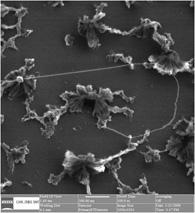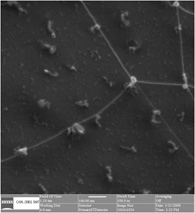Working in partnership with Carl Zeiss SMT Inc., we developed the capabilities and applications of the world’s first commercial scanning helium ion microscope (SHIM)- the Zeiss Orion. The larger mass and therefore smaller de Broglie wavelength of helium ions compared to electrons means that the SHIM suffers less from diffraction effects than a scanning electron microscope (SEM). This, combined with the extremely small and bright source (courtesy of the atomically sharp tip at which helium atoms are ionised), and the small interaction volume of the beam in the sample enables sub nanometer resolution to be achieved along with a depth of field up to 5 times larger than in an SEM. Our system is equipped with an Everhart-Thornley secondary electron detector, giving outstanding resolution and topographical contrast, and micro channel plate backscattered ion detector which produces images exhibiting excellent materials contrast. To add functionality, the Orion SHIM can also be equipped with:
- A Gas Injection System (GIS) for material deposition by using the helium ion source.
- An energy dispersive backscattered ion detector for compositional analysis. It is capable of detecting monolayers of material deposited on a substrate.
- A Gatan MonoCL cathodoluminescence system, used for material luminescence studies based on excitation by a charged particle.
The four main areas for investigation are:
- Ion induced luminescence spectroscopy with the Gatan MonoCL system, including tests on materials known to exhibit cathodoluminescence in the visible- near IR range, e.g. quantum dots, fluorescent dyes, followed by investigations into tagging biological samples.
- Material modification, including direct sputtering by helium ions and the use of the GIS for deposition and etching.
- Ion scattering spectroscopy for characterisation of thin films and for small particle compositional analysis.
- Ion induced patterning (direct write lithography).
In addition, we welcome enquiries from other groups with samples that may benefit from the unique characterisation capabilities the Orion can offer.


